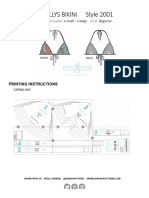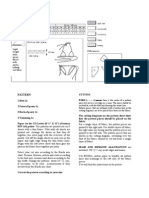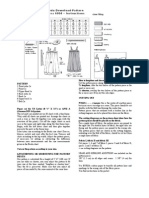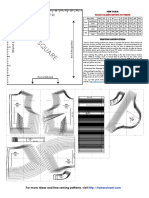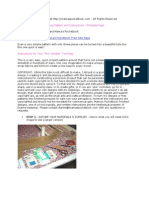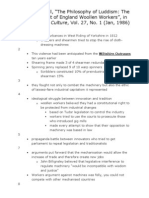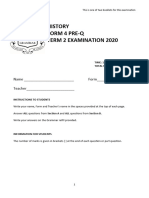What Is Grading?: SNP' Refers To The Side Neck Point. If
What Is Grading?: SNP' Refers To The Side Neck Point. If
Uploaded by
Urania CordovaCopyright:
Available Formats
What Is Grading?: SNP' Refers To The Side Neck Point. If
What Is Grading?: SNP' Refers To The Side Neck Point. If
Uploaded by
Urania CordovaOriginal Title
Copyright
Available Formats
Share this document
Did you find this document useful?
Is this content inappropriate?
Copyright:
Available Formats
What Is Grading?: SNP' Refers To The Side Neck Point. If
What Is Grading?: SNP' Refers To The Side Neck Point. If
Uploaded by
Urania CordovaCopyright:
Available Formats
KNITTED GRADING RULES
What is Grading?
HOW TO
Ok some of you who pattern cut might know what grading is but the likelihood is that you probably don't or won't have come across this. You know when you pick up you knitting pattern and it tells you how many stitches for a size 10 and then how many for a 12 !ell there is usually more for the size 12. "f you look along the sizes# there should be a standard $ump between each size# for e%ample a &' sts per size might be 12# 1(# 20# 2'# 2)# so each size increases ' sts for every size. *his &' is called a grading rule. +ow for the e%ample above# this is a little misleading because "'ve put it into a knitting and stitches conte%t. ,sually grading rules are done in a measurement format and then depending on your tension s-uare or swatch# this will translate over to stitches. .o the grading rules# in measurements# will always stay consistent in every pattern or design but depending on your tension s-uare# the amount of stitches will change. .o to start let's go over the measurement points on the body first.
SNP' refers to the side neck point. "f you are not sure what this is# take a $umper and look at the shoulder seam. "t is the point nearest to your neck on the shoulder seam where the front panel and back panel meet the collar seam# usually a rib.
www.twistedangle.co.uk
www.twistedangle.co.uk
www.twistedangle.co.uk
www.twistedangle.co.uk
KNITTED GRADING RULES
NOTES ON THE GRAPHIC and MEASUREMENTS:
HOW TO
/ave you ever gone shopping and been one size in shop 0 and then been a bigger size in shop 1 !ell grading and sizing are very specific to each retailer or designer and each retailer has to start with what's called a fit model. *his person# the fit model# is the fit standard for their base size in all garments and products# then their grading rules are applied on top# scaling the fit model so to speak. /owever we all know that there is no standard size and that each size# as you move up or down# is not a carbon copy $ust scaled. "f you are thinking of using grading rules for your own products or pattern making# it's important to note that these can really only been given as a rough guide and you'll have to decide for yourself what is most appropriate for your customers or clients. /owever# most grading rules only vary slightly in fit so use the guide below to help you 2&345 +ow before we get into the rules themselves# it's important to note that these are for the 'average' person. +ot many e%ist " know# including me# so for petite clothes you will need to reduce any of the length measurements and of course where they are measured from# if this is determined by length# like the waist and hips for e%ample. 0lso it is generally agreed by clothing manufacturers that over a certain size# the body starts to change shape a little bit so the grading rules then start to increase per $ump. 6or e%ample if on the average size the cuff rule was 0.7cm# for plus size this might be a 0.)cm per size. 8epending on how large or small you want to go# this increase in $ump usually happens every 74( sizes. "t is also agreed and a reason a lot of retailers only make up to a size 1( ,9 is that at size 1) the first increase $ump occurs. *he important thing to remember if you are considering making up grading rules for a product# customer or service is that you can't please everyone. !e are all made in different shapes and sizes so you can only really use a middle ground.
*hese are general measurements and measurement points that " use for the ,9 fashion industry. !oven garment and knitted3$ersey garment sizes are in fact different when they are made due to the stretch and type of fabric construction. .o you shouldn't compare these to a woven size chart. *he top numbers below are 'on the flat'. *his is the measurement taken when the garment is laid flat and measured at specific points. *hey are half of the total garment. *he measurements below are all .9"+ *":/*# so you may want to add some additional cms 2or 'give'5 for clothes. *here are many points on the body to measure so "'ve included the main ones. .maller ones are usually between 0.;40.7cm and larger ones usually 142.7cm. <easurements of length# like trousers or sleeves# rarely change.
UK SIZE European SIZE US SIZE Bust
2.7cm under armhole '0cm down from .+>
8 36 4
;;.7 (=cm 2?.7 7? ;1.7 (; 7? ;1 1'.7 2? =.7 17
www.twistedangle.co.uk
10 38 6
;( =2cm ;2 (' ;' () 7? ;2 17 ;0 ) 1(
12 40 8
;).7 ==cm ;'.7 (? ;(.7 =; 7? ;; 17.7 ;1 ).7 1=
14 42 10
'1 )2cm ;= =' ;? =) 7? ;' 1( ;2 ? 1)
16 44 12
';.7 )=cm ;?.7 =? '1.7 ); 7? ;7 1(.7 ;; ?.7 1?
+/GRADE RULE
2.7 7 2.7 7 2.7 7 0 1 0.7 1 0.7 1
a!st
"op #e$
(0cm down from .+> 2for tops5
S%ee&e Len't( S(ou%)er B!*ep +u,,
@rown to @uff measured straight .houlder seam to .houlder .eam ,nder armhole# straight across sleeve .traight across opening of the cuff
www.twistedangle.co.uk
www.twistedangle.co.uk
www.twistedangle.co.uk
You might also like
- Combinaison CelineDocument46 pagesCombinaison CelinesofrancaisesNo ratings yet
- Campfire SkitsDocument16 pagesCampfire SkitstapansNo ratings yet
- Personal Hygiene & GroomingDocument16 pagesPersonal Hygiene & GroomingKit100% (2)
- Key Word Transformation ExercisesDocument20 pagesKey Word Transformation ExercisesSilver Lining90% (10)
- Crocheter's Companion, The - Brown, Nancy PDFDocument133 pagesCrocheter's Companion, The - Brown, Nancy PDFAnca Gligor100% (8)
- Teach Yourself Stitch Craft and Dressmaking Volume IV: Pattern Drafting for Men and Practice Drafts - Trying your hand at drafting shirtsFrom EverandTeach Yourself Stitch Craft and Dressmaking Volume IV: Pattern Drafting for Men and Practice Drafts - Trying your hand at drafting shirtsNo ratings yet
- Simplified Systems of Sewing Styling - Lesson Two, Pattern AlterationFrom EverandSimplified Systems of Sewing Styling - Lesson Two, Pattern AlterationNo ratings yet
- Sewing 101: Pocket Guide: A Guide to Necessary Skills for Garment MakingFrom EverandSewing 101: Pocket Guide: A Guide to Necessary Skills for Garment MakingNo ratings yet
- The Perfect Fit: Creating and Altering Basic Sewing Patterns for Tops, Sleeves, Skirts, and PantsFrom EverandThe Perfect Fit: Creating and Altering Basic Sewing Patterns for Tops, Sleeves, Skirts, and PantsRating: 5 out of 5 stars5/5 (1)
- Teach Yourself Stitch Craft and Dressmaking Volume VII: Important Tips Before Stitching - Estimation of cloth and other tipsFrom EverandTeach Yourself Stitch Craft and Dressmaking Volume VII: Important Tips Before Stitching - Estimation of cloth and other tipsNo ratings yet
- Intermediate Guide to Pattern Fitting and Alteration: 7 Projects and Little-Known Tricks to Fit and Design GarmentsFrom EverandIntermediate Guide to Pattern Fitting and Alteration: 7 Projects and Little-Known Tricks to Fit and Design GarmentsRating: 1.5 out of 5 stars1.5/5 (4)
- The Notebook Inpsired Vintage Dress Instructions PDFDocument4 pagesThe Notebook Inpsired Vintage Dress Instructions PDFЕкатерина РостоваNo ratings yet
- C228 PDFDocument8 pagesC228 PDFtemplarhistri18No ratings yet
- 003 Capitulo 3 Basicos de Corpiño y FaldaDocument65 pages003 Capitulo 3 Basicos de Corpiño y FaldawhilmeragudeloNo ratings yet
- AlvaBlock ManualDocument6 pagesAlvaBlock Manualinama33No ratings yet
- Frida Huipil InstructionsDocument6 pagesFrida Huipil InstructionsChapo ThomasNo ratings yet
- Sewing: The Cutting Layouts Are On The Pattern SheetDocument2 pagesSewing: The Cutting Layouts Are On The Pattern Sheetmunteanu_oana_7100% (1)
- Pants, Part 1, The PatternDocument5 pagesPants, Part 1, The PatternEarl PattersonNo ratings yet
- BL Us A Burda Style 6003 InstruccionesDocument3 pagesBL Us A Burda Style 6003 InstruccionesRicardo AtiamNo ratings yet
- Orca Share Media1548755810861Document4 pagesOrca Share Media1548755810861Mike Marquis100% (1)
- Assessment 123Document10 pagesAssessment 123Arren Shem CabansiNo ratings yet
- Pattern Making DesignDocument1 pagePattern Making Designinama330% (2)
- 010 Capitulo 10Document23 pages010 Capitulo 10whilmeragudeloNo ratings yet
- Dollys Bikini Style 2001: Sizes Included: LevelDocument2 pagesDollys Bikini Style 2001: Sizes Included: LevelmarijastoilovicNo ratings yet
- Shorts DirectionsDocument3 pagesShorts Directionsapi-530222998No ratings yet
- The Essential Guide To Sewing With LaceDocument2 pagesThe Essential Guide To Sewing With LaceamyNo ratings yet
- A Hint of HistoryDocument2 pagesA Hint of HistoryrachelllllllllllllllNo ratings yet
- Everyday CardiganDocument3 pagesEveryday CardiganmxpxaxoNo ratings yet
- 006 Capitulo 6 Traslados de Pinza 3Document11 pages006 Capitulo 6 Traslados de Pinza 3whilmeragudelo100% (1)
- 2014 GBSB 1930s BlouseDocument21 pages2014 GBSB 1930s BlousemicaultNo ratings yet
- Pattern: FOLD ( - ) Means: Here Is The Center of A PatternDocument3 pagesPattern: FOLD ( - ) Means: Here Is The Center of A PatternErin Padgett MercadoNo ratings yet
- Learn To Sew - Zipper in Pants Fly Front With Extended FacingsDocument3 pagesLearn To Sew - Zipper in Pants Fly Front With Extended FacingsRommel BauzaNo ratings yet
- Coffee Date Dress Multisize Sample OriginalDocument2 pagesCoffee Date Dress Multisize Sample OriginalClau NarváezNo ratings yet
- Fashion Glossary TerminologyDocument17 pagesFashion Glossary TerminologylazzycazzNo ratings yet
- Bra MeasurementDocument2 pagesBra Measurementr_chilveriNo ratings yet
- Platye R 80-152Document10 pagesPlatye R 80-152Nguyen Tra100% (1)
- Adding Bust Darts To A Tee Shirt PatternDocument2 pagesAdding Bust Darts To A Tee Shirt PatternJS100% (1)
- Vestido para El Verano Burdastyle 6004 Patron Gratis InstruccionesDocument3 pagesVestido para El Verano Burdastyle 6004 Patron Gratis InstruccionesRoxy ParedesNo ratings yet
- SORTURI - Tipare2Document27 pagesSORTURI - Tipare2Dany Mel100% (1)
- 017 Capitulo 17Document15 pages017 Capitulo 17whilmeragudeloNo ratings yet
- Gar 8Document32 pagesGar 8ShoaibNo ratings yet
- #2448 - ENGLISH Women's Stretch Thermal Socks: Socks - Use Wide and Short Zigzag Stitch Only - Do Not Use SergerDocument1 page#2448 - ENGLISH Women's Stretch Thermal Socks: Socks - Use Wide and Short Zigzag Stitch Only - Do Not Use SergerPedroPalotesNo ratings yet
- 2773 General Directions: Cutting/Marking The PatternDocument4 pages2773 General Directions: Cutting/Marking The Patternsmug97No ratings yet
- Sewing Summer Shorts Tutorial and PatternDocument7 pagesSewing Summer Shorts Tutorial and Patternsirambo1No ratings yet
- Katty Ruffle Trim Tie Back BlouseDocument20 pagesKatty Ruffle Trim Tie Back BlouseLuzameire Moura da SilvaNo ratings yet
- Anita: By: BurdastyleDocument37 pagesAnita: By: BurdastyleÍñigo Félix Marzo100% (3)
- Basic Trouser BlockDocument7 pagesBasic Trouser BlockDamilola HassanNo ratings yet
- Draft A Kimono Sleeve From Block PatternDocument34 pagesDraft A Kimono Sleeve From Block PatternDamaris GNo ratings yet
- Vestido Basico PDFDocument17 pagesVestido Basico PDFEliana Rojas AllendeNo ratings yet
- "Sarong Wrap Pants": SuppliesDocument3 pages"Sarong Wrap Pants": Supplieshamba_dah100% (1)
- Beach Party Top & Dress Pattern v2Document11 pagesBeach Party Top & Dress Pattern v2ElyzaBellaNo ratings yet
- A Basic Pattern For You, Jane Speece, 1977Document9 pagesA Basic Pattern For You, Jane Speece, 1977Dan Andrei StefanNo ratings yet
- Molde de ColeteDocument20 pagesMolde de ColeteDivane SoaresNo ratings yet
- Avery Tiered Shirt Dress Tutorial and Free PatternDocument16 pagesAvery Tiered Shirt Dress Tutorial and Free PatternWestwickate100% (1)
- Pajamas PatternDocument32 pagesPajamas Patternalrey100% (1)
- SN Ebook 11Document23 pagesSN Ebook 11templarhistri18100% (4)
- Etta Pleated Flounce DressDocument27 pagesEtta Pleated Flounce DressEly DanelNo ratings yet
- Free "Pink October" Tote Bag Pattern and Instructions - Printable PageDocument9 pagesFree "Pink October" Tote Bag Pattern and Instructions - Printable Pagemonica100% (1)
- MCC 5466Document3 pagesMCC 5466Alexandra Popescu100% (1)
- Mila OriginalDocument9 pagesMila OriginalMarija MartacNo ratings yet
- sm18-04 en CigarillopantsDocument13 pagessm18-04 en Cigarillopantsdaisy22No ratings yet
- Garment Technology EbooksDocument24 pagesGarment Technology EbooksmithonlinkNo ratings yet
- Grecian Sundress Instructions2Document3 pagesGrecian Sundress Instructions2Snezana100% (1)
- Sword BimbosDocument8 pagesSword Bimbos735liptolNo ratings yet
- Industry Data BaseDocument14 pagesIndustry Data BaseJamalSultan100% (1)
- CentroDocument10 pagesCentroAbbas hedayatiNo ratings yet
- Philippine Normal University: The National Center For Teacher EducationDocument75 pagesPhilippine Normal University: The National Center For Teacher EducationSteeven Tom V. PascuaNo ratings yet
- Senior Orientation Co 2025Document45 pagesSenior Orientation Co 2025mortensenkNo ratings yet
- 2022. AV1 (Anh Văn 1) - Trắc Nghiệm (Chưa Đáp Án)Document32 pages2022. AV1 (Anh Văn 1) - Trắc Nghiệm (Chưa Đáp Án)haiha21175No ratings yet
- Philosophy of LuddismDocument5 pagesPhilosophy of LuddismGlyn EvansNo ratings yet
- Cinderella Ball GownDocument51 pagesCinderella Ball GownaponojecyNo ratings yet
- British Columbia Nova Scotia: A Unique DialectDocument6 pagesBritish Columbia Nova Scotia: A Unique DialectМарія ГалькоNo ratings yet
- King of Immortal Tithe (Ben Alderson)Document293 pagesKing of Immortal Tithe (Ben Alderson)Fredelyn Fernandez100% (1)
- Escola Secundária Braamcamp Freire - Pontinha: Clique Aqui para Ver A CorrecçãoDocument6 pagesEscola Secundária Braamcamp Freire - Pontinha: Clique Aqui para Ver A CorrecçãoFilipa I SantosNo ratings yet
- 2009 FRN Average WeightsDocument4 pages2009 FRN Average WeightsKristine ReyesNo ratings yet
- TechMahindra Nonverbal Reasoning Questions PDFDocument46 pagesTechMahindra Nonverbal Reasoning Questions PDFkrish100% (1)
- A Perilous Circumstance - Beers, LauraDocument249 pagesA Perilous Circumstance - Beers, LauraJose Milton CaicedoNo ratings yet
- Geo110 Exam 1Document4 pagesGeo110 Exam 1yuhuh076 uhhNo ratings yet
- Real English Unit 1 Revision TestDocument5 pagesReal English Unit 1 Revision TestAlfredoLagunasDelgadoNo ratings yet
- F4 T2 2020 Exam GnetDocument3 pagesF4 T2 2020 Exam GnetrazaraamisNo ratings yet
- BỘ ĐỀ ÔN CK 2 - FF5Document59 pagesBỘ ĐỀ ÔN CK 2 - FF5tranthihongtrang2710No ratings yet
- The American Sharps Shooters-2016-5Document20 pagesThe American Sharps Shooters-2016-5musgrave762100% (2)
- CROCSDocument24 pagesCROCSMary Jean Dela CruzNo ratings yet
- List of Common Spanish Words, Phrases, Nouns, and VerbsDocument4 pagesList of Common Spanish Words, Phrases, Nouns, and VerbsAjDonNo ratings yet
- Listening Test 2Document4 pagesListening Test 25scy8w4cfyNo ratings yet
- Basic Illustrated Camping 2nd Edition Cliff Jacobson Download PDFDocument74 pagesBasic Illustrated Camping 2nd Edition Cliff Jacobson Download PDFjilbabselina100% (2)
- Q1 Grade 8 ARTS DLL Week 5 6Document9 pagesQ1 Grade 8 ARTS DLL Week 5 6Ronyla EnriquezNo ratings yet
- Relative Clauses of Time - EnglishDocument17 pagesRelative Clauses of Time - EnglishGiordano ArgentaNo ratings yet
- 4709 Kiem Tra Ngu Phap Tieng AnhDocument12 pages4709 Kiem Tra Ngu Phap Tieng AnhVõ Phi TrúcNo ratings yet
























